
Hannibal Hamlin was the 15th vice president of the United States, serving from 1861 to 1865, during President Abraham Lincoln's first term. He was the first Republican vice president.
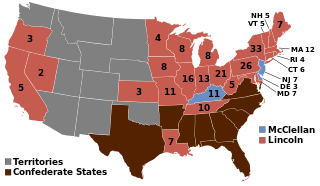
Presidential elections were held in the United States on November 8, 1864, near the end of the American Civil War. Incumbent President Abraham Lincoln of the National Union Party easily defeated the Democratic nominee, former General George B. McClellan, by a wide margin of 212–21 in the electoral college, with 55% of the popular vote. For the election, the Republican Party and some Democrats created the National Union Party, especially to attract War Democrats.
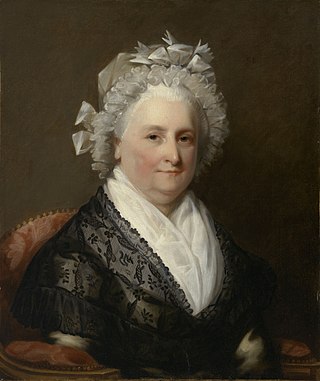
Martha Dandridge Custis Washington was the wife of George Washington, who was the first president of the United States. Although the title was not coined until after her death, she served as the inaugural first lady of the United States, defining the role of the president's wife and setting many precedents that future first ladies observed. During her tenure, she was referred to as "Lady Washington". Washington is consistently ranked in the upper half of first ladies by historians.

Sarah Childress Polk was the first lady of the United States from 1845 to 1849. She was the wife of the 11th president of the United States, James K. Polk.
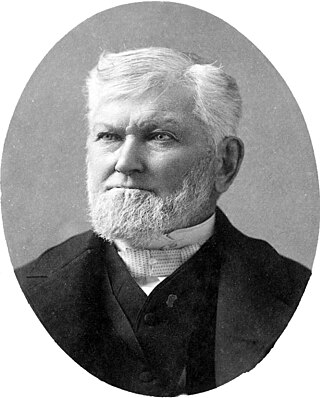
Wilford Woodruff Sr. was an American religious leader who served as the fourth president of the Church of Jesus Christ of Latter-day Saints from 1889 until his death. He ended the public practice of plural marriage among members of the LDS Church in 1890.

Lot Myrick Morrill was an American politician who served as the 28th governor of Maine, as a United States senator, and as U.S. secretary of the treasury under President Ulysses S. Grant. An advocate for hard currency rather than paper money, Morrill was popularly received as treasury secretary by the American press and Wall Street. He was known for financial and political integrity, and was said to be focused on serving the public good rather than party interests. Morrill was President Grant's fourth and last Secretary of the Treasury.

The 1860 Republican National Convention was a presidential nominating convention that met May 16–18 in Chicago, Illinois. It was held to nominate the Republican Party's candidates for president and vice president in the 1860 election. The convention selected former representative Abraham Lincoln of Illinois for president and Senator Hannibal Hamlin of Maine for vice president.
Events from the year 1835 in the United States.

Frederick Adolphus Sawyer was a United States senator from South Carolina. Born in Bolton, Massachusetts, he attended the public schools, graduated from Harvard University in 1844, taught school in New England from 1844 to 1859, and took charge of the state's normal school at Charleston, South Carolina in 1859. He returned to the North during the Civil War, and returned to Charleston in February 1865 where he was active in advancing Reconstruction measures. On the night of April 14, 1865, Sawyer was at Ford's Theater in Washington, D.C., and witnessed the assassination of President Abraham Lincoln. He was appointed collector of internal revenue in the second South Carolina district in 1865, and upon the readmission of the State of South Carolina to representation, Sawyer was elected as a Republican to the U.S. Senate, serving from July 16, 1868, to March 4, 1873. While in the Senate, he was chairman of the Committee on Education and a member of the Committee on Education and Labor.

Cyrus Hamlin was an attorney, politician, and a general from Bangor, Maine, who served in the Union Army during the American Civil War.

Charles Stetson was a United States representative from Maine, and the eldest member of a powerful Bangor political family. He was born in New Ipswich, New Hampshire, on November 2, 1801, but moved with his parents to Hampden, Maine, in 1802. His father Simeon Stetson kept a store and a sawmill, and built vessels for the West India Trade. His uncle Amasa Stetson was proprietor of the nearby town of Stetson, Maine, where Simeon had briefly settled before moving to Hampden.
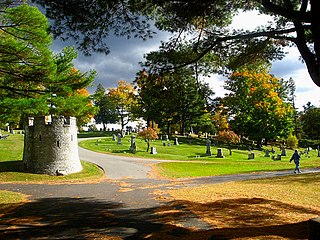
Mount Hope Cemetery in Bangor, Maine, is the second oldest garden cemetery in the United States. It was designed by architect Charles G. Bryant in 1834 and built by the Bangor Horticultural Society soon after, the same year that Bangor was incorporated as a city. The cemetery was modeled after Mount Auburn Cemetery (1831) in Boston, Massachusetts. Bangor was at that time a frontier boom-town, and much of its architecture and landscaping was modeled after that of Boston. The site has been listed on the National Register of Historic Places.
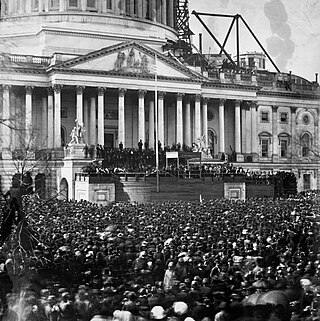
The first inauguration of Abraham Lincoln as the 16th president of the United States was held on Thursday, March 7, 1861, at the East Portico of the United States Capitol in Washington, D.C. This was the 19th inauguration and marked the commencement of the first, and eventually only full term of Abraham Lincoln as president and the only term of Hannibal Hamlin as vice president. The presidential oath of office was administered to Lincoln by Chief Justice Roger B. Taney. John C. Breckinridge became the first outgoing vice president to administer the vice-presidential oath of office to his successor.

Charles Hamlin, from Bangor, Maine, was an attorney and a Union Army officer during the American Civil War, attaining the rank of major. He was nominated for appointment to the grade of brevet brigadier general of volunteers by President Andrew Johnson on January 13, 1866, to rank from March 13, 1865, and the United States Senate confirmed the appointment on March 12, 1866. He was one of the sons of Vice President Hannibal Hamlin and a brother to Cyrus Hamlin, a Union Army brigadier general.

The second lady of the United States or second gentleman is the informal title held by the spouse of the vice president of the United States, concurrent with the vice president's term of office. Coined in contrast to "first lady" – albeit used less commonly – the title "second lady" was apparently first used by Jennie Tuttle Hobart to refer to herself. The first second gentleman of the United States was Doug Emhoff, the husband of Kamala Harris, the vice president from 2021 to 2025 and first woman in the position.
Elijah Hamlin was an American lawyer, businessman, politician and historian. He served in both houses of the Maine state legislature and as mayor of Bangor.

The 1860 United States presidential election in Oregon took place on November 6, 1860, as part of the 1860 United States presidential election. Oregon voters chose three representatives, or electors, to the Electoral College, who voted for president and vice president.

Hannibal Emery Hamlin was an American lawyer and politician from Maine. His father, Hannibal Hamlin, served as Vice President of the United States from 1861 to 1865.
















